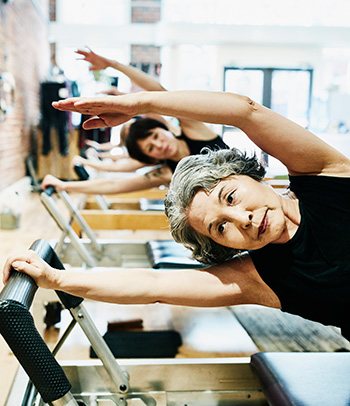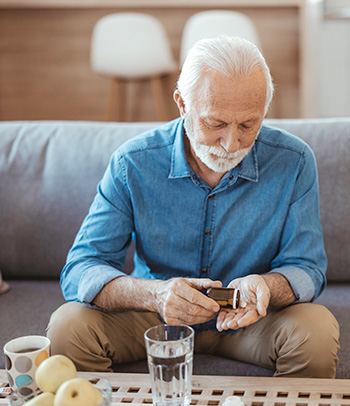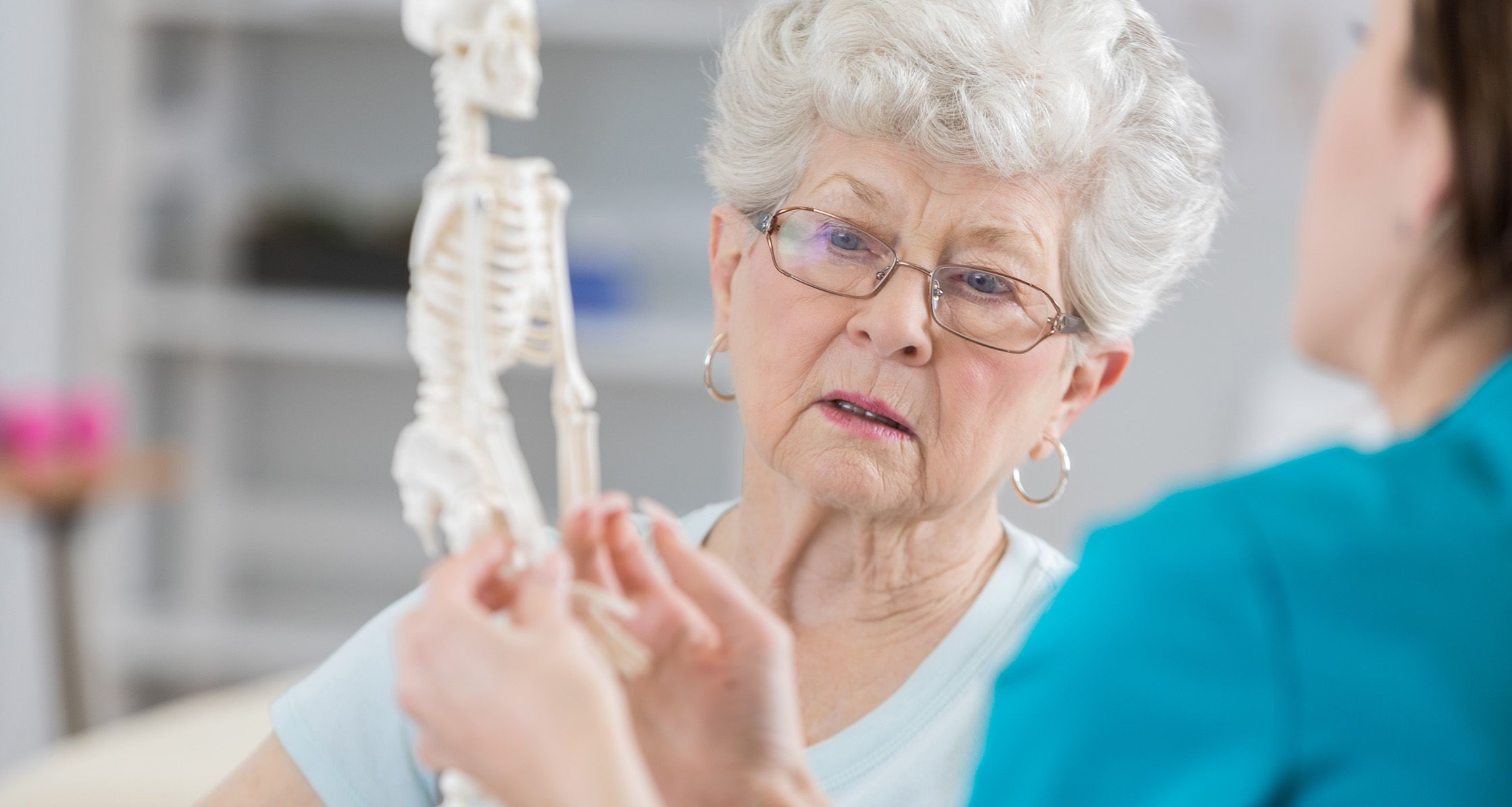As we age, our bodies change. It’s not just more wrinkles around the eyes or aches and pains when we wake up. Our bones start to change too. When we get older, our bones begin to lose density and strength. This is called osteoporosis. Osteoporosis affects almost 20% of women and almost 5% of men over the age of 50.
The good news is you can improve your bone health at any age! Through education, proper screening and positive lifestyle changes, you can help to ensure your bones remain strong and healthy as you age.
What Is Osteoporosis?
Through education, proper screening and positive lifestyle changes, you can help to ensure your bones remain strong and healthy as you age.
Osteoporosis is a condition that causes the quality and strength of your bones to decrease. When this happens, your bones become fragile and can fracture or break more easily.
Osteoporosis is often called a “silent” disease because most people don’t even know they have it until they break a bone. Common symptoms include fractures, joint or back pain, a reduction in height or a stooped-over posture.
Fractures can occur in any bone but happen most often in bones of the hip, vertebrae in the spine and the wrist. When you suffer from osteoporosis, your bones may become weak enough to fracture from minor falls (that normally would not cause a break in a healthy bone), or from normal stresses such as bending, lifting or even coughing.
Who Is At Risk for Osteoporosis?
In the United States, millions of people already have osteoporosis or are at high risk for developing it. It can affect women and men of all races and ethnic groups, but some groups are at a greater risk. Factors that may increase your risk for osteoporosis include:
- Body type – Slender, thin-boned women and men are at greater risk because they have less bone to lose compared to larger-boned people.
- Family history – If one or more of your parents has osteoporosis or a hip fracture, you’re at greater risk for developing it.
- Certain medications – Certain medications, such as some cancer medications or type 2 diabetes medications, may increase your risk, so talk to your health care provider about how your medications may impact your bone health.
- Age – As you age, bone loss happens more quickly, and new bone growth is slower. Women who have passed menopause and women and men over the age of 50 are at greater risk.
- Sex and race – Osteoporosis is most common in white, non-Hispanic women and Asian women. However, women of all races and ethnic groups over the age of 50 are still at significant risk. White men are at higher risk than other races, but all men, especially those over the age of 70, are most at risk.
- Lifestyle – Your lifestyle choices play a large role in your bone health and your risk for osteoporosis, including:
- Diets low in calcium, vitamin D and protein can contribute to weaker bones.
- Low levels of physical activity or long periods of inactivity can contribute to an increased rate of bone loss.
- Chronic or heavy drinking and smoking are also risk factors for poor bone health.
- Veteran status – According to studies done by the National Library of Medicine, Veterans are more likely to develop bone-related illnesses due to multiple risk factors, such as prior injuries.
How Can I Protect Myself From Osteoporosis?
 You don’t have to wait until you break a bone to take steps to improve your bone health and density. Here are some steps you can take to get started:
You don’t have to wait until you break a bone to take steps to improve your bone health and density. Here are some steps you can take to get started:
- Stay physically active. Weight-bearing exercises such as walking, jogging and dancing are great for your bones. In addition, activities such as yoga, Tai Chi and strength training can help you improve strength, balance and coordination. Doing any of these outside in the sun can also help you get some extra vitamin D!
- Eat a nutritious diet. A diet rich in calcium and vitamin D will help you maintain good bone health.
- Add beans, dark leafy greens and dairy products such as milk, yogurt and cheese to your diet to get enough calcium and vitamin D daily.
- Avoid highly processed foods and foods with a lot of salt which cause your body to lose calcium.
- Check out MyPlate, which offers you guidance on picking healthy foods. You can search for calcium-rich foods and recipes too.
- Protect yourself from falling. Falls are the number one cause of fractures in older adults. You can protect yourself by improving your balance through exercise, getting your eyes checked regularly and making your home safer.
- Maintain a healthy lifestyle. In addition to exercise and a healthy diet, eliminating heavy alcohol use and quitting smoking can improve your bone health and density.
- Talk to your health care provider. You and your health care provider can discuss your risk factors, decide whether you should be screened and determine a healthy, safe plan to work on your bone health.
- Get screened. Currently, screening is recommended for women who are 65 years old or older and for women who are 50-64 and have certain risk factors such as the ones listed above. The screening, called the DEXA or dual-energy X-ray absorptiometry, is offered through the Department of Veterans Affairs (VA) and measures your bone density.
What Resources Are Available?
 VA can help you identify and reduce your risk and diagnose and treat osteoporosis. Specific services include DEXA scans, medications and preventative care programs, including:
VA can help you identify and reduce your risk and diagnose and treat osteoporosis. Specific services include DEXA scans, medications and preventative care programs, including:-
- VA’s MOVE! Weight Management Program for help with exercise and healthy eating
- VA’s Whole Health Program for resources such as Tai Chi, yoga and nutrition advice
- Smoking cessation resources including counseling, text messaging programs and more
- Registered dieticians available to help you adopt a diet rich in calcium and vitamin D
- VA’s Healthy Teaching Kitchen for recipes, cookbooks, cooking videos and handouts on nutrient-dense foods
- Resources for preventing falls and making your home safer
- The Centers for Disease Control and Prevention offers more information on osteoporosis, including a fall prevention checklist and tips to improve bone health.
- The National Institutes of Health offers several resources on osteoporosis, including how to improve calcium intake, answers to frequently asked questions and more.
Making healthy lifestyle choices and accessing resources designed with your health in mind are key to keeping your bones strong and healthy.







